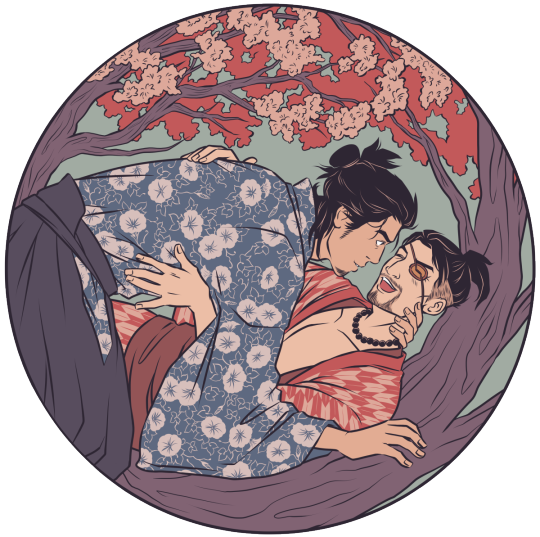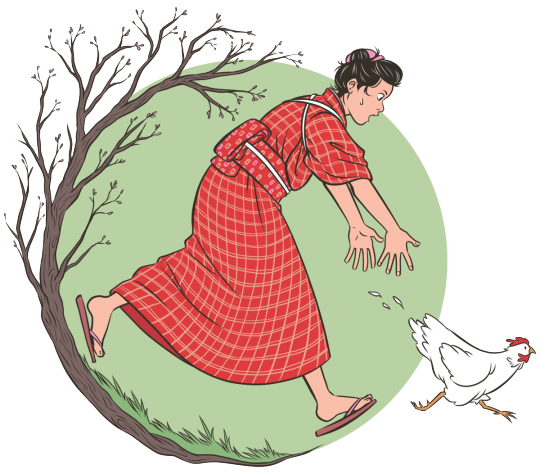#I mean there's pretty much nobody writing ishin fic at this point and I can't figure out why
Explore tagged Tumblr posts
Text




Back in late 2022, I started working on a long story about Ishin: a tale of two dummies whose weird one-night stand blossoms into a surprisingly caring relationship even as a (mostly) canon-compliant series of tragedies plays out around them. It’s a now-complete series in approximately 125,000 words and three parts, and you can read the whole thing right now on AO3: The Glorious and Bloody Deeds of Okita Soji, Volume 1: Okita Soji Versus the Scoundrel Saito Hajime; The Secret History of Saito Hajime, Volume 2: The Shiraume Incident; and, finally, Brief Notes on the Domestic Life of one Saito Hajime.
Taken as a whole, it's a story about identity and history and the stories that people tell each other and themselves about those things. And it's a story about one guy getting way too into weird Edo-era egg dishes, and another guy finding himself embroiled in an extended detective sequence, and a third guy composing a series of corny haiku that (almost) nobody wants to read. And, of course, it's also a story about people who are shamelessly and sometimes explicitly in love (so you probably shouldn't read it at work).
This whole big, sprawling thing has been a labour of love on my part: it turns out that I adore writing historical fiction and finding excuses to read books and journal articles in order to write it better. In addition to making not one but four little illustrations to celebrate the fic's completion (and please look at them up-close; I hand-inked all those kimono patterns), I've drawn up a list of some of the sources that I consulted for my writing, and you can find those under the cut.
This is not an absolutely exhaustive list of sources; I don’t think it’s super useful to catalogue the extremely nitty-gritty stuff, like that time that I felt compelled to find out what the state of strawberry cultivation was in 1860s Japan, or when I needed to picture exactly what it looked like when Haruka was repairing Ryoma’s kimono. That being said, I’ve added a couple of things that are really particular to my stories but that I thought were cool enough to share.
Foster, Michael Dylan. The Book of Yokai: Mysterious Creatures of Japanese Folklore. U of California P, 2015. (This one was a really fun read – it combines a short history of yokai in folklore with a little catalogue of yokai.)
Jansen, Marius B. Sakamoto Ryoma and the Meiji Restoration. Stanford UP, 1971. (Super useful as an introduction to the Bakumatsu era and for biographical details about Ryoma and the figures around him.)
“Japanese Wiki Corpus.” https://www.japanesewiki.com/. (This is a machine-translated collection of articles on the Japanese side of Wikipedia related to Kyoto. As with a lot of things on Wikipedia, the citations on these articles tend to be poor or nonexistent, but it’s a useful starting point for information on figures and events that don’t have an English wiki equivalent. Definitely more useful if you can then head over to the original wiki articles and parse them out yourself.)
“Kabuki21” and “The Noh.” https://www.kabuki21.com/section.php, https://www.the-noh.com/en/plays/index.html. (I’m lumping these two together because I tended to consult them in tandem. Without getting too much into my personal details I am – among other things – a non-practicing theatre scholar, so whenever I wanted to have characters in my old-timey fics refer to something cultural, my first stop was old plays. These sites have, respectively, summaries of kabuki plays and full texts of Noh plays available for you to browse. If you’ve read my other fics you will probably have seen that I referred to the kabuki play “Fuwa” in 亀が如く.)
Katsu, Kokichi. Musui’s Story: The Autobiography of a Tokugawa Samurai. Translated by Teruko Craig. U of Arizona P, 1988. (A book that needs to be taken with a grain of salt because it’s an autobiography written by a guy who sounds like a real blowhard, but it’s still a really fascinating look into the daily life of a low-ranking samurai.)
Leupp, Gary P. and Tao, De-min. The Tokugawa World. Routledge, 2022. (Of particular interest is Kimura Sachihiko’s essay, “The Shinsengumi: Shadows and light in the last days of the Tokugawa shogunate” [1104-1124], which gave me a bunch of incidental details about the Roshigumi that I incorporated into the sections of this series that were told from Inoue and Hijikata’s perspectives.)
“Old Photos of Japan.” https://www.oldphotosjapan.com/. (Pretty self-explanatory. Very useful as a resource for picturing scenes!)
“Shinsengumi Archives.” https://shinsengumi-archives.tumblr.com/. (A long-running tumblr dedicated to cataloguing resources about the Shinsengumi. There’s an absolute wealth of information collected here, and best of all, the creator cites their sources and even provides links to the original texts. Although it’s focused on the Shinsengumi, it’s impossible to overstate how useful this site is for prospective Bakumatsu-era fic writers in general. The collection of Hijikata’s poems with links to others’ translations and commentary is here: https://shinsengumi-archives.tumblr.com/post/683071924948058112/hijikata-toshizos-haiku-poems. The creator of the blog also links to a translation of Nagakura’s and Shimada’s diaries, and while the document is machine-translated, it’s still a great source of historical details: https://shinsengumi-archives.tumblr.com/post/678083336614428672/where-can-you-read-the-memoirs.)
Smits, Gregory. “Warding off Calamity in Japan: A Comparison of the 1855 Catfish Prints and the 1862 Measles Prints.” EASTM 30 (2009): 9-31. (Okay, this one is highly specific to my fic – it comes up in Part 2 when Okita tells his story about Kashima and again a couple of chapters later when his pile of remedies includes a crudely-drawn picture meant to ward off indigestion – but I love little details like this so I did want to make a point of sharing it here.)
“Tamago Hyakuchin” and “Tofu Hyakuchin.” http://codh.rois.ac.jp/edo-cooking/tamago-hyakuchin/recipe/, https://toyama-tofu.jp/tofuhyakutin.html. (These are collections of Edo-era egg- and tofu-based recipes. They’re two of the sources cited in Cookpad’s collection of modernized Edo-era recipes: https://cookpad.com/recipe/list/14604664.)
Vaporis, Constantine N. “Linking the Realm: The Gokaido Highway Network in Early Modern Japan (1603-1868).” Highways, Byways and Road Systems in the Pre-Modern World. Ed. Susan E. Alcock, John Bodel, and Richard J. A. Talbert. Wiley-Blackwell, 2012. 90-105. (Some of the works cited in this article also sound interesting, but I didn’t have a chance to dig any deeper as I just wanted to know a bit about the Tokugawa-era roads. Also interesting in this vein is Jilly Traganou’s book The Tokaido Road: Travelling and Representation in Edo and Meiji Japan [2004].)
Wert, Michael. Meiji Restoration Losers. Harvard UP, 2013. (Not directly useful as a source for writing about Ishin – it’s about later events and it mostly tracks the posthumous construction of one specific Tokugawa magistrate’s history – but it was an engaging read and I found it interesting as an exploration of how people continue to look back on the Bakumatsu era and the Meiji Restoration, which is something that the game is, of course, also doing.)
Yamakawa, Kikue. Women of the Mito Domain: Recollections of Samurai Family Life. Translated by Kate Wildman Nakai. U of Tokyo P, 1992. (Another one of those bits of essential reading on everyday life for low-ranking samurai, this time with a focus on women’s lives and households more generally. I didn’t use a lot of from this book in my fic, but it has everything from translations of songs to records of families’ financial transactions, and it’s fascinating to read about all the turmoil in Mito playing out in the background of these families’ lives.)
“Yokai.com.” https://yokai.com/. (The creators of this site make a point of not going into detail about their sources, and they’re very careful to state that they don’t intend for the project to be “the final authority” on yokai, but I enjoyed browsing the site to get some ideas for Okita’s stories – and once you know the name of a particular yokai that you’re interested in, it’s easy enough to go look up other sources on them.)
#like a dragon ishin#crime boys#my art#I know I said I was going to turn my attention to the mainline games after wrapping this series up but#what if I just never got off the ishin train#I mean there's pretty much nobody writing ishin fic at this point and I can't figure out why#it almost feels like I have a duty#anyway I hope if you read this fic you also find yourself thinking about my extremely cringe ishin rarepair
126 notes
·
View notes